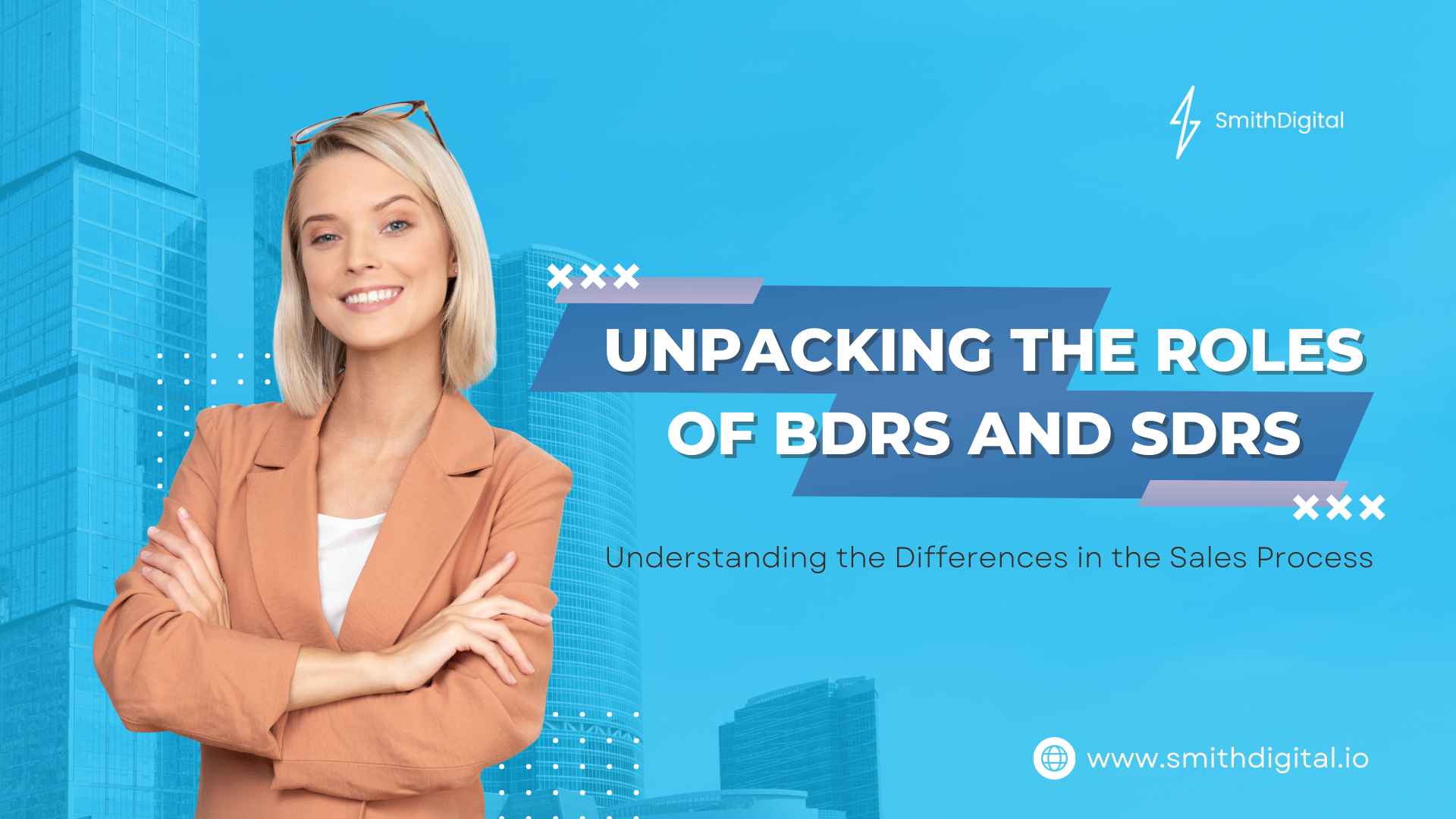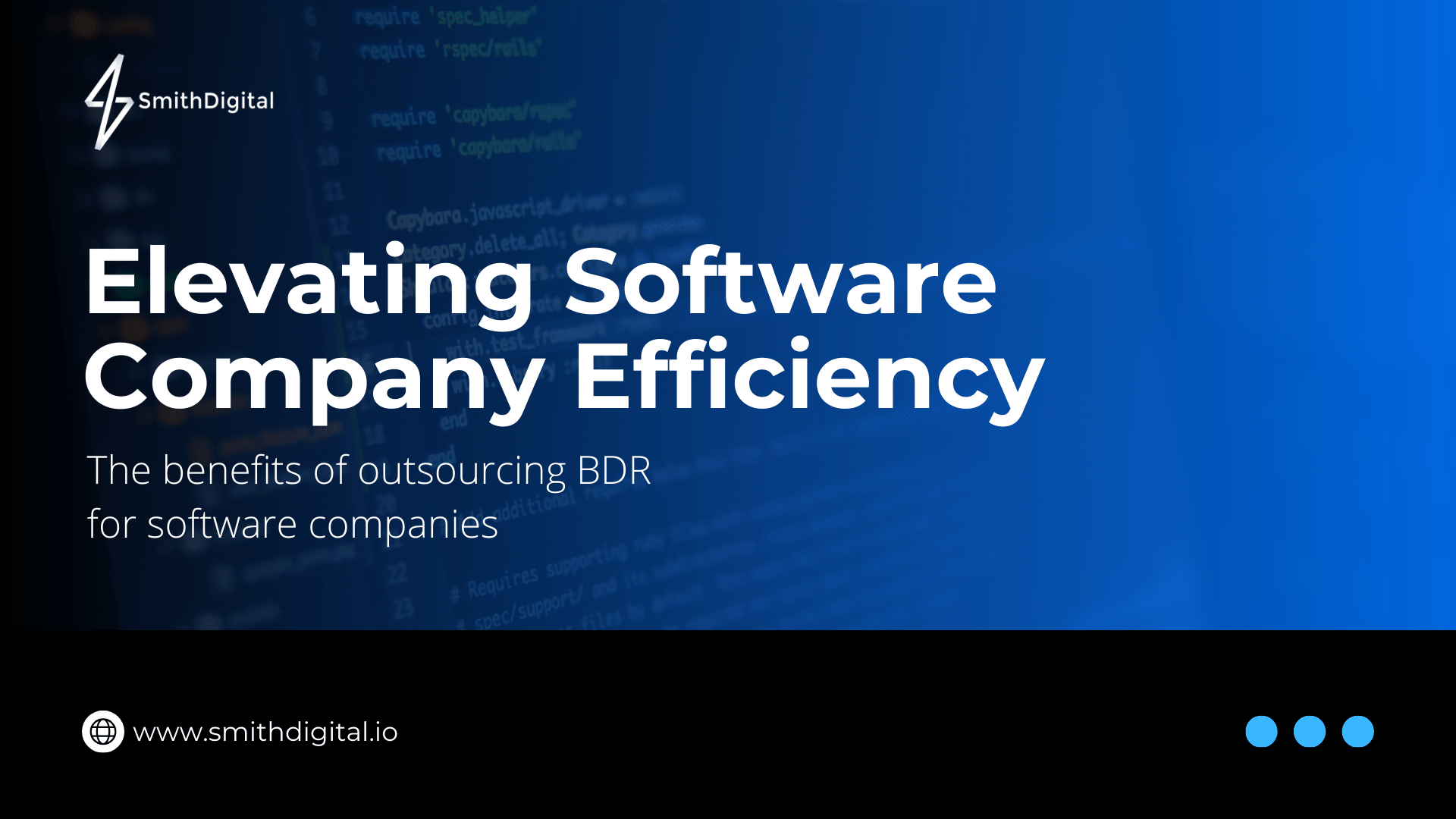Unpacking the Roles of BDRs and SDRs: Understanding the Differences in the Sales Process
Are you considering hiring a Business Development Representative (BDR) or a Sales Development Representative (SDR) for your company? Understanding...
%20(23).png?width=302&height=302&name=_SD%20web%20assets%202025%20(500%20x%20500%20px)%20(23).png)
What’s the Difference Between a BDR and an SDRSales leaders and marketing managers often find themselves asking a simple but important question: what’s the difference between a BDR and an SDR? On the surface, these titles may look interchangeable, but the truth is that each plays a distinct role within the sales team. Understanding the difference between a business development representative (BDR) and a sales development representative (SDR) can help companies optimize their sales process, build a stronger pipeline, and ultimately close more deals.
The distinction matters because companies that misalign or misunderstand these roles often end up with gaps in their sales funnel. Leads are either left unqualified or opportunities are missed because there was no one focused on uncovering them. This blog will explain the meaning and responsibilities of both roles, highlight the key differences between them, and explore when businesses should prioritize one over the other. We’ll also look at how both BDRs and SDRs collaborate with account executives and when outsourcing these roles makes sense as part of a growth strategy.
![]() SDR stands for sales development representative. This role is one of the most critical components of the sales funnel because it acts as the bridge between marketing efforts and the sales team. An SDR is responsible for qualifying leads that come in through inbound channels. These channels might include website form fills, content downloads, webinar registrations, or responses to marketing campaigns.
SDR stands for sales development representative. This role is one of the most critical components of the sales funnel because it acts as the bridge between marketing efforts and the sales team. An SDR is responsible for qualifying leads that come in through inbound channels. These channels might include website form fills, content downloads, webinar registrations, or responses to marketing campaigns.
The SDR role is designed to ensure that every potential customer who shows interest in a company’s product or service is properly nurtured. For example, when a prospect downloads a whitepaper, the SDR follows up to assess their level of interest and determine if they are ready to engage with an account executive. If they are not ready, the SDR nurtures them further, moving them through the early stages of the sales process until they are considered sales qualified leads.
By focusing on lead qualification, SDRs help prevent the sales team from wasting time on contacts who are unlikely to buy. Instead, they make sure that the account executives receive prospects who are more likely to convert, allowing the sales team to work efficiently.
An SDR is responsible for a number of activities in the initial stages of the sales cycle. These include responding to inbound inquiries, making follow-up calls, sending emails, and managing outreach sequences to prospects who have already shown some level of interest.
Speed matters—a study found that sales teams who respond within five minutes of an inbound inquiry are 9 times more likely to convert the lead (HubSpot, 2023). This highlights why SDRs are vital for ensuring that high-intent prospects are acted on promptly before interest cools.
The SDR team focuses on creating shorter sales cycles by qualifying as many inbound prospects as possible and handing them over to the account executives. A well-trained SDR ensures that no valuable lead is lost between marketing and sales. They set sales appointments, manage calendars for executives, and ensure a steady flow of opportunities moves through the pipeline.
This approach supports the company’s sales strategies by making inbound leads more predictable. It also keeps the sales pipeline active and allows account executives to focus on closing deals rather than chasing down early-stage prospects.
![]() BDR meaning is business development representative, a role that focuses on generating new business opportunities through outbound sales. Unlike SDRs, who qualify inbound leads, BDRs are responsible for finding potential customers who have not yet engaged with the company. The BDR role requires more prospecting skill and persistence because it involves outreach to people who may not be actively searching for a solution.
BDR meaning is business development representative, a role that focuses on generating new business opportunities through outbound sales. Unlike SDRs, who qualify inbound leads, BDRs are responsible for finding potential customers who have not yet engaged with the company. The BDR role requires more prospecting skill and persistence because it involves outreach to people who may not be actively searching for a solution.
BDR responsibilities include cold calling, sending outbound emails, connecting with executives on LinkedIn, and generally identifying potential opportunities that fit the company’s ideal customer profile.
Even though these prospects may not be actively searching, outbound leads close at a rate 40% higher than inbound leads in B2B sales (Sales Insights Lab, 2023). This reflects the potential value of outbound outreach—especially in complex or enterprise sales.
BDRs and SDRs both play essential roles in building the sales pipeline, but the BDR role is often more challenging because it focuses on outbound lead generation. The work of BDRs is essential for companies that want to expand into new markets or target industries that do not naturally come through inbound marketing channels.
The BDR is responsible for the early stages of the sales process by identifying new business opportunities. This means BDRs must research accounts, find the right contacts, and begin conversations that lead to future sales. While BDRs may have fewer leads compared to SDRs, their leads often represent higher-value opportunities.
The BDR role is critical for creating long-term growth and ensuring that the company is not fully dependent on inbound marketing efforts. When combined with the SDR role, BDRs provide balance by making sure the sales team always has new accounts to work with while SDRs ensure existing inbound demand is handled effectively.
The difference between SDR and BDR responsibilities largely comes down to inbound versus outbound. SDRs focus on managing the leads that come into the company through marketing channels, while BDRs go out and create new opportunities through outbound sales activities.
An SDR typically has a higher quantity of leads to manage because inbound marketing can generate significant volume. On the other hand, a BDR may have fewer leads but their work is centered on opening up opportunities that otherwise would not exist. This makes the BDR role especially important in industries with longer or more complex sales cycles.
For instance, an SDR might qualify a lead who downloaded an eBook, while a BDR might cold call an executive at a company that fits the target profile but has never engaged with the brand. Together, SDRs and BDRs ensure both inbound and outbound demand are captured.
Comparing BDR vs SDR reveals that each role contributes at different stages of the sales process. SDRs engage with prospects who are already in the funnel, nurturing them and ensuring they are ready for account executives. BDRs, on the other hand, focus on the very top of the sales funnel by generating new outbound opportunities.
Both roles are essential for creating a balanced sales pipeline. The SDR ensures no inbound lead is wasted while the BDR ensures new accounts are always being introduced into the process. Companies that understand the difference between a BDR and SDR are better equipped to structure their sales team effectively.
It’s worth noting that sales team titles can vary across organizations. Some companies combine the roles into a single sales development rep position, while others split them into distinct BDR and SDR teams. Regardless of the title, the core distinction remains the same: inbound versus outbound responsibility.
Companies with strong inbound lead generation from marketing efforts should consider investing in SDR teams. If marketing campaigns are producing a steady flow of prospects, then SDR services are critical for qualifying those leads. The SDR role ensures that marketing and sales efforts are aligned, and that valuable leads are not lost.
An SDR team is particularly effective for organizations with shorter sales cycles, where prospects are likely to move quickly from interest to purchase. For example, a SaaS company with significant website traffic and frequent demo requests benefits from a well-structured SDR team to handle inbound demand.
SDRs not only qualify leads but also nurture them until they are ready for account executives. This reduces friction in the sales process and helps maximize the return on marketing investments.
Companies looking to expand into new markets or industries should prioritize BDR teams. The BDR focuses on outbound lead generation and building relationships with prospects who may not even be aware of the product or service.
This approach is particularly valuable for businesses with longer and more complex sales cycles. For example, an enterprise technology provider trying to break into the financial sector may not receive many inbound leads from banks. A BDR team can proactively identify executives in target banks and begin outreach campaigns.
While BDRs typically manage fewer leads compared to SDRs, the leads they generate can represent higher-value accounts. BDRs open the door for account executives to enter conversations with strategic prospects, creating opportunities for new business that would not come through inbound channels alone.
Both SDR and BDR roles exist to create opportunities for account executives. Once a lead is qualified—whether inbound through SDR or outbound through BDR—it is handed off to an account executive who is responsible for managing the advanced stages of the sales process and ultimately closing the deal.
For example, an SDR may nurture a prospect until they request a demo. At that point, the lead is passed to an account executive who runs the demo and manages the negotiation process. Similarly, a BDR may secure an initial meeting with an executive at a target account, and then the account executive takes over to drive the sale forward.
This handoff process is critical because it ensures account executives are only spending their time with sales qualified leads. This increases sales efficiency and improves the likelihood of successful outcomes.
The collaboration between SDRs, BDRs, and account executives is vital for a successful sales strategy. SDR and BDR teams must align their efforts with account executives to ensure a smooth transition from prospecting to closing. Regular communication and shared KPIs help keep everyone focused on the same goals.
When sales team members collaborate effectively, the pipeline remains healthy and balanced. BDRs generate outbound opportunities, SDRs qualify inbound leads, and account executives close deals. Senior sales executives can then focus on more complex sales or larger strategic accounts, knowing that the pipeline is consistently being filled and nurtured.
Building a large in-house sales development team can be expensive and time-consuming—especially for companies trying to scale quickly or test new markets. Outsourced BDR and SDR teams offer a flexible, cost-effective way to ramp up sales activity without the burden of hiring and training new staff.
In fact, 65% of B2B companies outsource some or all of their BDR functions to accelerate outbound prospecting and expand into new territories efficiently (Bridge Group, 2023). These outsourced teams often come equipped with proven sales strategies, advanced tools, and industry expertise that help generate pipeline faster than internal teams can typically achieve on their own.
To explore whether this is the right move for your team, check out our outsourced BDR services and how we help companies scale with precision.
For a deeper dive into how outbound sales fits into a scalable growth plan, download the free SmithDigital Digital Growth Playbook — packed with practical frameworks for marketing, sales, and revenue leaders.
Deciding whether to keep sales development in-house or to outsource depends on company goals and resources. In-house SDRs provide deep product knowledge and direct alignment with marketing and sales teams, making them valuable for nurturing inbound leads. Outsourced BDRs, on the other hand, provide speed, scalability, and the ability to test outbound sales strategies without long-term commitments.
Many companies find that a hybrid model works best. For example, an organization may use in-house SDRs to manage inbound demand while partnering with outsourced BDR services to expand into new territories. This combination balances efficiency with growth, ensuring a steady stream of qualified leads flows to the account executives.
The difference between a BDR and SDR comes down to inbound versus outbound. SDRs focus on qualifying inbound prospects, while BDRs generate new business opportunities through outbound efforts. Both roles are essential to building a strong sales pipeline and ensuring that account executives have a consistent flow of sales qualified leads.
For marketing managers and sales leaders, the key is to align SDR and BDR strategies with broader growth goals. Whether the focus is on maximizing inbound ROI, expanding into new markets, or achieving a balance of both, structuring the sales team around these roles is critical to long-term success.
Companies that want to scale faster should also consider the benefits of outsourcing BDR and SDR services. External support can provide the flexibility and speed needed to accelerate growth while keeping internal teams focused on closing deals.

Are you considering hiring a Business Development Representative (BDR) or a Sales Development Representative (SDR) for your company? Understanding...

Software companies are currently facing heightened competition and a greater need to fill their sales pipelines with qualified leads. Outsourcing BDR...

A 2024 B2B Market and Customer Experience Report by Digital Commerce 360 revealed that 70% of B2B buyers prefer purchasing products online even...